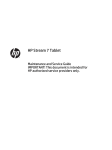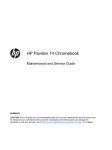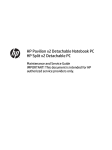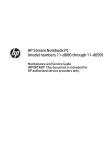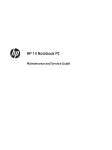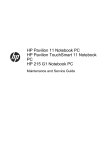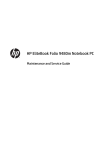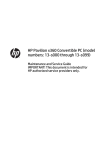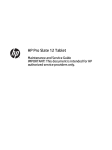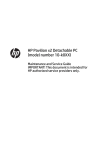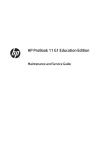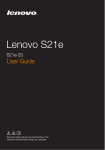Download HP Stream x360 Convertible PC
Transcript
HP Stream x360 Convertible PC Maintenance and Service Guide IMPORTANT! This document is intended for HP authorized service providers only. © Copyright 2014 Hewlett-Packard Development Company, L.P. Bluetooth is a trademark owned by its proprietor and used by Hewlett-Packard Company under license. Atom, Celeron, and Intel are trademarks of Intel Corporation in the U.S. and other countries. Microsoft and Windows are U.S. registered trademarks of the Microsoft group of companies. SD Logo is a trademark of its proprietor. The information contained herein is subject to change without notice. The only warranties for HP products and services are set forth in the express warranty statements accompanying such products and services. Nothing herein should be construed as constituting an additional warranty. HP shall not be liable for technical or editorial errors or omissions contained herein. First Edition: October 2014 Document Part Number: 793705-001 Product notice This guide describes features that are common to most models. Some features may not be available on your computer. Not all features are available on all editions of Windows 8. This computer may require upgraded and/or separately purchased hardware, drivers, and/or software to take full advantage of Windows 8 functionality. See http://www.microsoft.com for details. Software terms By installing, copying, downloading, or otherwise using any software product preinstalled on this tablet, you agree to be bound by the terms of the HP End User License Agreement (EULA). If you do not accept these license terms, your sole remedy is to return the entire unused product (hardware and software) within 14 days for a refund subject to the refund policy of your place of purchase. For any further information or to request a full refund of the tablet, please contact your local point of sale (the seller). Safety warning notice WARNING! To reduce the possibility of heat-related injuries or of overheating the device, do not place the device directly on your lap or obstruct the device air vents. Use the device only on a hard, flat surface. Do not allow another hard surface, such as an adjoining optional printer, or a soft surface, such as pillows or rugs or clothing, to block airflow. Also, do not allow the AC adapter to contact the skin or a soft surface, such as pillows or rugs or clothing, during operation. The device and the AC adapter comply with the useraccessible surface temperature limits defined by the International Standard for Safety of Information Technology Equipment (IEC 60950-1). iii iv Safety warning notice Table of contents 1 Product description ....................................................................................................................................... 1 2 External component identification ................................................................................................................. 3 Right side ............................................................................................................................................................... 3 Left side ................................................................................................................................................................. 4 Display ................................................................................................................................................................... 6 Changing your notebook to an entertainment stand ......................................................................... 7 Changing your notebook to a tablet ................................................................................................... 7 Top ......................................................................................................................................................................... 8 TouchPad ............................................................................................................................................. 8 Speakers .............................................................................................................................................. 8 Lights ................................................................................................................................................... 9 Keys ................................................................................................................................................... 10 Service label and PCID label ................................................................................................................................ 11 Service label ...................................................................................................................................... 11 PCID label ........................................................................................................................................... 12 3 Illustrated parts catalog .............................................................................................................................. 13 Computer major components ............................................................................................................................. 13 Display assembly subcomponents ..................................................................................................................... 17 Mass storage devices .......................................................................................................................................... 19 Miscellaneous parts ............................................................................................................................................. 19 Sequential part number listing ........................................................................................................................... 19 4 Removal and replacement procedures preliminary requirements .................................................................... 22 Tools required ...................................................................................................................................................... 22 Service considerations ........................................................................................................................................ 22 Plastic parts ....................................................................................................................................... 22 Cables and connectors ...................................................................................................................... 23 Drive handling ................................................................................................................................... 23 Grounding guidelines ........................................................................................................................................... 24 Electrostatic discharge damage ....................................................................................................... 24 Packaging and transporting guidelines ......................................................................... 25 Workstation guidelines ................................................................................ 25 v 5 Removal and replacement procedures for Authorized Service Provider parts ................................................... 27 Component replacement procedures ................................................................................................................. 27 Bottom cover ..................................................................................................................................... 28 USB board .......................................................................................................................................... 32 WLAN module .................................................................................................................................... 33 WWAN module ................................................................................................................................... 35 Power button board .......................................................................................................................... 37 Speakers ............................................................................................................................................ 38 Battery ............................................................................................................................................... 40 TouchPad ........................................................................................................................................... 42 Power connector cable ...................................................................................................................... 43 System board .................................................................................................................................... 44 Display assembly .............................................................................................................................. 47 6 Using Setup Utility (BIOS) and HP PC Hardware Diagnostics (UEFI) ................................................................... 55 Starting Setup Utility (BIOS) ................................................................................................................................ 55 Updating the BIOS ................................................................................................................................................ 55 Determining the BIOS version ........................................................................................................... 55 Downloading a BIOS update .............................................................................................................. 56 Using HP PC Hardware Diagnostics (UEFI) .......................................................................................................... 57 Downloading HP PC Hardware Diagnostics (UEFI) to a USB device .................................................. 57 7 Specifications ............................................................................................................................................. 58 Computer specifications ...................................................................................................................................... 58 8 Backup and recovery .................................................................................................................................... 59 Backing up your information ............................................................................................................................... 59 Performing a system recovery ............................................................................................................................ 59 Recovery from external media ......................................................................................................... 59 Using Windows Refresh or Windows Reset ...................................................................................... 60 9 Power cord set requirements ........................................................................................................................ 61 Requirements for all countries ........................................................................................................................... 61 Requirements for specific countries and regions ............................................................................................... 62 10 Recycling .................................................................................................................................................. 64 Index ............................................................................................................................................................. 65 vi 1 Product description Category Description Product Name HP Stream x360 Convertible PC Processor Intel® Celeron® N2840 processor (up to 2.58 GHz, 2 MB L2, 1333 MHz, dual core) Chipset Intel Atom™ Graphics Internal graphics: Intel HD Graphics Support for DX11 Support for HD playback, streaming, and recording @ 720p 30fps Panel 11.6 in [29.5 cm] (1366×768), high-definition (HD), white light emitting diode (WLED), AntiGlare, flat panel TouchScreen with MultiTouch enabled; 16:9 ultra-wide aspect ratio; typical brightness: 200 nits (cd/m2) Supports low-voltage differential signaling (LVDS) (co-layout with eDP1.3+PSR) Memory On-board system memory Support for DDR3L-1333 MHz (DDR3L-1600 MHz downgrade to DDR3L-1333 MHz) Supports up to 2 GB max on-board system memory (2048 MB (256 MB × 16 x 4pcs)) Optical drive Support for external 9.5 mm tray load, SATA, DVD+/-RW DL SuperMulti drive only Audio and video Integrated HP TrueVision camera: HD (1280×720 by 30 frames per second), fixed (no tilt), with activity light Dual array Digital Microphones with appropriate software - beam forming, echo cancellation, noise suppression DTS Studio Sound Dual Speakers support 25 mm x 14 mm speaker Ethernet Integrated 10/100 network interface card (NIC) Co-layout with Giga-LAN Sensor Sensor Hub (Accelerometer + Gyroscope + e-Compass) Wireless Compatible with Miracast-certified devices Support Assistant GPS Integrated wireless local area network (WLAN) options by way of wireless module; 1 antenna Support for the following WLAN format: ● Broadcom BCM43142 802.11 b/g/n 1x1 Wi-Fi + Bluetooth® 4.0 HMC Combo Adapter Integrated wireless wide area network (WWAN) options by way of wireless module; 2 antennas Support for the following WWAN format: ● HP hs3110 HSPA+ Mobile Broadband Module SIM card slot (user accessible) 1 Category Description External media cards HP Multi-Format Digital Media Card Reader with push-push technology. Supports SD/SDHC/SDXC. SIM slot Ports Keyboard/pointing devices ● AC adapter: HP Smart pin plug (4.5 mm barrel) ● Audio: one combo audio-out (headphone)/audio-in (microphone) jack, supports jack autodetection ● HDMI: v. 1.4a, supporting up to 1080p, 1920×1080 at 60 Hz ● RJ-45/Ethernet ● (1) USB 3.0 ● (2) USB 2.0 ● VGA (Dsub 15 pin) supporting 1920×1200 external resolution at 60 Hz, hot plug/unplug and auto-detection for correct output to wide-aspect versus standard aspect video 97% size, textured, island-style keyboard (no numerical keypad) Touchpad requirements: HP Imagepad - Clickpad with image sensor Taps enabled as default Multitouch gestures enabled Support for PS/2 and SMB interface Support for Windows 8.1 Modern TouchPad Gestures Power requirements 1 meter length power cord AC adapter with localized cable plug support Support for the following AC adapter: ● 45 W HP Smart AC adapter (non-PFC, with 26.5 mm z-height adapter [non-slim]) (not for India/People’s Republic of China) Embedded 3 cell, 43 Wh, prismatic battery Security Security cable lock slot Operating system Preinstalled: ● Serviceability End user replaceable parts: ● 2 Chapter 1 Product description Windows 8.1 (WIMBoot) AC adapter 2 External component identification Right side Component Description (1) SIM slot (select models only) Supports a wireless subscriber identity module (SIM). (2) Memory card reader Reads optional memory cards that store, manage, share, or access information. To insert a card, hold the card label-side up, with connectors facing the slot, insert the card into the slot, and then push in on the card until it is firmly seated. To remove a card, press in on the card it until it pops out. (3) USB 2.0 port Connects an optional USB device, such as a keyboard, mouse, external drive, printer, scanner or USB hub. (4) USB 3.0 port Connects an optional USB device, such as a keyboard, mouse, external drive, printer, scanner or USB hub. (5) HDMI port Connects an optional video or audio device, such as a highdefinition television, any compatible digital or audio component, or a high-speed HDMI device. (6) RJ-45 (network) jack/status lights Connects a network cable. (7) (8) AC adapter/battery light Power connector ● White: The network is connected. ● Amber: Activity is occurring on the network. ● On: The AC adapter is connected and the battery is charged. ● Off: The computer is using battery power. Connects an AC adapter. Right side 3 Left side Component (1) Description Security cable slot Attaches an optional security cable to the computer. NOTE: The security cable is designed to act as a deterrent, but it may not prevent the computer from being mishandled or stolen. (2) Power button ● When the computer is off, press the button to turn on the computer. ● When the computer is on, press the button briefly to initiate Sleep. ● When the computer is in the Sleep state, press the button briefly to exit Sleep. ● When the computer is in Hibernation, press the button briefly to exit Hibernation. CAUTION: Pressing and holding down the power button will result in the loss of unsaved information. If the computer has stopped responding and Windows shutdown procedures are ineffective, press and hold the power button down for at least 5 seconds to turn off the computer. To learn more about your power settings, see your power options. From the Start screen, type power, select Power and sleep settings, and then select Power and sleep from the list of applications. (3) 4 Power light ● On: The computer is on. ● Blinking: The computer is in the Sleep state, a powersaving state. The computer shuts off power to the display and other unneeded components. ● Off: The computer is off or in Hibernation. Hibernation is a power-saving state that uses the least amount of power. (4) USB 2.0 port Connects an optional USB device, such as a keyboard, mouse, external drive, printer, scanner or USB hub. (5) Audio-out (headphone)/Audio-in (microphone) jack Connects optional powered stereo speakers, headphones, earbuds, a headset, or a television audio cable. Also connects an optional headset microphone. This jack does not support optional microphone-only devices. Chapter 2 External component identification Component Description WARNING! To reduce the risk of personal injury, adjust the volume before putting on headphones, earbuds, or a headset. For additional safety information, refer to the Regulatory, Safety, and Environmental Notices. To access this guide, from the Start screen, type support, and then select the HP Support Assistant app. NOTE: When a device is connected to the jack, the computer speakers are disabled. NOTE: Be sure that the device cable has a 4-conductor connector that supports both audio-out (headphone) and audioin (microphone). (6) Volume up/down button Controls speaker volume. To decrease speaker volume, press the – edge of the button. To increase speaker volume, press the + edge of the button. Left side 5 Display Component Description (1) WWAN antennas (2)* (select models only) Send and receive wireless signals to communicate with wireless wide area networks (WWAN). (2) Internal microphones (2) Record sound. (3) Webcam light On: The webcam is in use. (4) Webcam Records video and captures photographs. Some models allow you to video conference and chat online using streaming video. To use the webcam, from the Start screen, type camera, and then select Camera from the list of applications. (5) WLAN antenna* Sends and receives wireless signals to communicate with wireless local area networks (WLANs). (6) Windows button Returns you to the Start screen from an open app or the Windows desktop. NOTE: Pressing the Windows key again will return you to the previous screen. (7) Internal display switch Turns off the display and initiates Sleep if the display is closed while the power is on. NOTE: The internal display switch is not visible from the outside of the computer. *The antennas are not visible from the outside of the computer. For optimal transmission, keep the areas immediately around the antennas free from obstructions. For wireless regulatory notices, see the section of the Regulatory, Safety, and Environmental Notices that applies to your country or region. To access this guide, from the Start screen, type support, and then select the HP Support Assistant app. 6 Chapter 2 External component identification Your computer can function as a classic notebook, and in addition, the display can be rotated so that the computer transforms into an entertainment stand or a tablet. Changing your notebook to an entertainment stand To change your notebook to an entertainment stand, raise the display, and then rotate the display backward to a stand position (about 315 degrees). Changing your notebook to a tablet To change your notebook to a tablet, raise the display, and then rotate the display backward until it is flush with the computer bottom (360 degrees). Display 7 Top TouchPad Component (1) Description TouchPad zone Moves the on-screen pointer and selects or activates items on the screen. NOTE: The TouchPad also supports edge-swipe gestures. (2) Left TouchPad button Functions like the left button on an external mouse. (3) Right TouchPad button Functions like the right button on an external mouse. Speakers 8 Component Description Speakers (2) Produce sound. Chapter 2 External component identification Lights Component Description (1) Caps lock light On: Caps lock is on, which switches the keys to all capital letters. (2) Mute light ● Amber: Computer sound is off. ● Off: Computer sound is on. Top 9 Keys Component Description (1) esc key Displays system information when pressed in combination with the fn key. (2) fn key Executes frequently used system functions when pressed in combination with the b key, the spacebar, or the esc key. (3) Windows key Returns you to the Start screen from an open app or the Windows desktop. NOTE: Pressing the Windows key again will return you to the previous screen. (4) 10 Action keys Chapter 2 External component identification Execute frequently used system functions. Service label and PCID label Service label When ordering parts or requesting information, provide the computer serial number and model description provided on the service label. ● Serial number (s/n) (1). This is an alphanumeric identifier that is unique to each product. ● Part number/Product number (p/n) (2). This number provides specific information about the product's hardware components. The part number helps a service technician to determine what components and parts are needed. ● Warranty period (3). This describes the duration (in years) of the warranty period for the computer. ● Model (4). This is the alphanumeric identifier used to locate documents, drivers, and support for the computer. Service label and PCID label 11 PCID label The PCID label provides the information required to properly reset the notebook firmware (BIOS) back to factory shipped specifications when replacing the system board. The label may have a different number of characters depending on the operating system on the computer The PCID lable is located inside the bottom case. Windows 8 models Non-Windows 8 models 12 Chapter 2 External component identification 3 Illustrated parts catalog Computer major components NOTE: HP continually improves and changes product parts. For complete and current information on supported parts for your computer, go to http://partsurfer.hp.com, select your country or region, and then follow the on-screen instructions. Computer major components 13 14 Chapter 3 Illustrated parts catalog Item Component Spare part number (1) Display assembly (11.6 in [29.5 cm], AG, SVA, LED TouchScreen) (includes webcam/ microphone module): With WLAN and WWAN support 794293-001 With WLAN support 794294-001 The display assembly is also spared at the subcomponent level. See Display assembly subcomponents on page 17. (2) Top cover (includes keyboard) For use in Belgium 794301-A41 For use in Bulgaria 794301-261 For use in Canada 794301-DB1 For use in the Czech Republic and Slovakia 794301-FL1 For use in Denmark, Finland, and Norway 794301-DH1 For use in France 794301-051 For use in Germany 794301-041 For use in Greece 794301-151 For use in Israel 794301-BB1 For use in Italy 794301-061 For use in Latin America 794301-161 For use in the Netherlands 794301-B31 For use in Portugal 794301-131 For use in Romania 794301-271 For use in Russia 794301-251 For use in Saudi Arabia 794301-171 For use in Slovenia 794301-BA1 For use in Spain 794301-071 For use in Switzerland 794301-BG1 For use in Turkey 794301-141 For use in the United Kingdom 794301-031 (3) Power button board (includes cable) 755733-001 (4) TouchPad (includes bracket and cable) 794302-001 (5) Power connector cable 755727-001 (6) Speaker Kit (includes left and right speakers and cable) 794298-001 (7) System board (includes replacement thermal material): Intel Celeron N2840 processor, 2 GB memory, 32G eMMC, no WWAN support ,and the Windows 8.1 Standard operating system (includes replacement thermal material) 794299-501 Computer major components 15 Item Component Spare part number Intel Celeron N2840 processor, 2 GB memory, 32G eMMC, WWAN support, and the Windows 8.1 Standard operating system (includes replacement thermal material) 794300-501 (8) Thermal plate (not spared) (9) WLAN module: Broadcom BCM43142 802.11 b/g/n 1x1 Wi-Fi + Bluetooth 4.0 HMC Combo Adapter (10) 16 753076-005 WWAN module: HP hs3110 HSPA+ Mobile Broadband Module 748599-005 (11) Embedded 3 cell prismatic battery pack, 43 Wh, 3.82 Ah 787520-005 (12) USB board (includes cable) 755734-001 (13) Bottom cover Without WWAN support 794288-001 With WWAN support 794289-001 Chapter 3 Illustrated parts catalog Display assembly subcomponents NOTE: The display assembly is also spared as a whole assembly. Display assembly (11.6 in [29.5 cm], AG, SVA, LED TouchScreen) (includes webcam/microphone module) with WWAN and WLAN support: 794293-001 and display assembly (11.6 in [29.5 cm], AG, SVA, LED TouchScreen) (includes webcam/microphone module) with WLAN support: 794294-001. Item Component Spare part number (1) Display enclosure (supports both WWAN/non-WWAN models) 794287-001 (2) WLAN antenna 794285-001 Display assembly subcomponents 17 18 Item Component Spare part number (3) Webcam (includes microphone rubber gaskets) 794303-001 (4) WWAN dual antenna 794286-001 (5) Display cable 761350-001 (6) Display hinges 794308-001 (7) Display raw panel (includes display screw mylar covers and rubber gaskets) 794295-001 (8) Proximity sensor board 788218-001 (9) Display bezel for use with the raw panel (includes bezel, touch glass, touch control board, and magnets for hibernation and 360) 794290-001 (10) Display hinge covers (includes top and bottom covers) 794292-001 Chapter 3 Illustrated parts catalog Mass storage devices Component Spare part number External DVD±RW Double-Layer with SuperMulti Drive 747080-001 Miscellaneous parts Component Spare part number AC adapter 45 W HP Smart AC adapter (non-PFC, 4.5 mm, non-slim) (not for India/People’s Republic of China) 741727-001 HDMI to VGA adapter 701943-001 Power cord (3 pin, black, 1.83 m): For use in Argentina 755530-D01 For use in Denmark 755530-081 For use in Europe 755530-021 For use in Israel 755530-BB1 For use in Italy 755530-061 For use in North America 755530-001 For use in South Africa 755530-AR1 For use in Switzerland 755530-111 For use in the United Kingdom and Singapore 755530-031 Rubber Feet Kit (includes 2 rear rubber feet) 794296-001 Screw Kit 794297-001 Sequential part number listing Spare part number Description 701943-001 HDMI to VGA adapter 741727-001 45 W HP Smart AC adapter (non-PFC, 4.5 mm, non-slim) (not for India/People’s Republic of China) 747080-001 External DVD±RW Double-Layer with SuperMulti Drive 748599-005 HP hs3110 HSPA+ Mobile Broadband Module 753076-005 Broadcom BCM43142 802.11 b/g/n 1x1 Wi-Fi + Bluetooth 4.0 HMC Combo Adapter 755530-001 Power cord for use in North America (3-pin, black, 1.83 m) 755530-021 Power cord for use in Europe (3-pin, black, 1.83 m) 755530-031 Power cord for use in the United Kingdom and Singapore (3-pin, black, 1.83 m) 755530-061 Power cord for use in Italy (3-pin, black, 1.83 m) Mass storage devices 19 20 Spare part number Description 755530-081 Power cord for use in Denmark (3-pin, black, 1.83 m) 755530-111 Power cord for use in Switzerland (3-pin, black, 1.83 m) 755530-AR1 Power cord for use in the South Africa (3-pin, black, 1.83 m) 755530-BB1 Power cord for use in Israel (3-pin, black, 1.83 m) 755530-D01 Power cord for use in Argentina (3-pin, black, 1.83 m) 755727-001 Power connector cable 755733-001 Power button board (includes cable) 755734-001 USB board (includes cable) 761350-001 Display cable 787520-005 Embedded 3 cell, 43 Wh, 3.82 Ah, prismatic battery pack 788218-001 Proximity sensor board 794285-001 WLAN antenna 794286-001 WWAN dual antenna 794287-001 Display enclosure (supports both WWAN/non-WWAN models) 794288-001 Bottom cover without WWAN support 794289-001 Bottom cover with WWAN support 794290-001 Display bezel, for use with the raw panel (includes bezel, touch glass, touch control board, and magnets for hibernation and 360) 794292-001 Display hinge covers (includes top and bottom covers) 794293-001 Display panel kit with WWAN and WLAN support 794294-001 Display panel kit with WLAN support 794295-001 Display raw panel (includes display screw mylar covers and rubber gaskets) 794296-001 Rubber Feet Kit (includes 2 rear rubber feet) 794297-001 Screw Kit 794298-001 Speaker Kit (includes left and right speakers and cable) 794299-501 System board equipped with an Intel Celeron N2840 processor, 2 GB memory, 32G eMMC, no WWAN support, and the Windows 8.1 Standard operating system (includes replacement thermal material) 794300-501 System board equipped with an Intel Celeron N2840 processor, 2 GB memory, 32G eMMC, WWAN support, and the Windows 8.1 Standard operating system (includes replacement thermal material) 794301-031 Top cover for use in the United Kingdom (includes keyboard) 794301-041 Top cover for use in Germany (includes keyboard) 794301-051 Top cover for use in France (includes keyboard) 794301-061 Top cover for use in Italy (includes keyboard) 794301-071 Top cover for use in Spain (includes keyboard) 794301-131 Top cover for use in Portugal (includes keyboard) Chapter 3 Illustrated parts catalog Spare part number Description 794301-141 Top cover for use in Turkey (includes keyboard) 794301-151 Top cover for use in Greece (includes keyboard) 794301-161 Top cover for use in Latin America (includes keyboard) 794301-171 Top cover for use in Saudi Arabia (includes keyboard)) 794301-251 Top cover for use in Russia (includes keyboard)) 794301-261 Top cover for use in Bulgaria (includes keyboard) 794301-271 Top cover for use in Romania (includes keyboard) 794301-A41 Top cover for use in Belgium (includes keyboard) 794301-B31 Top cover for use Internationally (includes keyboard) 794301-BA1 Top cover for use in Slovenia (includes keyboard) 794301-BB1 Top cover for use in Israel (includes keyboard) 794301-BG1 Top cover for use in Switzerland (includes keyboard) 794301-DB1 Top cover for use in Canada (includes keyboard) 794301-DH1 Top cover for use in Denmark, Finland, and Norway (includes keyboard) 794301-FL1 Top cover for use in the Czech Republic and Slovakia (includes keyboard) 794302-001 TouchPad (includes bracket and cable) 794303-001 Webcam (includes microphone rubber gaskets) 794308-001 Display hinge Sequential part number listing 21 4 Removal and replacement procedures preliminary requirements Tools required You will need the following tools to complete the removal and replacement procedures: ● Flat-bladed screw driver ● Magnetic screw driver ● Phillips P0 and P1 screw drivers Service considerations The following sections include some of the considerations that you must keep in mind during disassembly and assembly procedures. NOTE: As you remove each subassembly from the computer, place the subassembly (and all accompanying screws) away from the work area to prevent damage. Plastic parts CAUTION: Using excessive force during disassembly and reassembly can damage plastic parts. Use care when handling the plastic parts. Apply pressure only at the points designated in the maintenance instructions. 22 Chapter 4 Removal and replacement procedures preliminary requirements Cables and connectors CAUTION: When servicing the computer, be sure that cables are placed in their proper locations during the reassembly process. Improper cable placement can damage the computer. Cables must be handled with extreme care to avoid damage. Apply only the tension required to unseat or seat the cables during removal and insertion. Handle cables by the connector whenever possible. In all cases, avoid bending, twisting, or tearing cables. Be sure that cables are routed in such a way that they cannot be caught or snagged by parts being removed or replaced. Handle flex cables with extreme care; these cables tear easily. Drive handling CAUTION: Drives are fragile components that must be handled with care. To prevent damage to the computer, damage to a drive, or loss of information, observe these precautions: Before removing or inserting a hard drive, shut down the computer. If you are unsure whether the computer is off or in Hibernation, turn the computer on, and then shut it down through the operating system. Before handling a drive, be sure that you are discharged of static electricity. While handling a drive, avoid touching the connector. Before removing a diskette drive or optical drive, be sure that a diskette or disc is not in the drive and be sure that the optical drive tray is closed. Handle drives on surfaces covered with at least one inch of shock-proof foam. Avoid dropping drives from any height onto any surface. After removing a hard drive, an optical drive, or a diskette drive, place it in a static-proof bag. Avoid exposing an internal hard drive to products that have magnetic fields, such as monitors or speakers. Avoid exposing a drive to temperature extremes or liquids. If a drive must be mailed, place the drive in a bubble pack mailer or other suitable form of protective packaging and label the package “FRAGILE.” Service considerations 23 Grounding guidelines Electrostatic discharge damage Electronic components are sensitive to electrostatic discharge (ESD). Circuitry design and structure determine the degree of sensitivity. Networks built into many integrated circuits provide some protection, but in many cases, ESD contains enough power to alter device parameters or melt silicon junctions. A discharge of static electricity from a finger or other conductor can destroy static-sensitive devices or microcircuitry. Even if the spark is neither felt nor heard, damage may have occurred. An electronic device exposed to ESD may not be affected at all and can work perfectly throughout a normal cycle. Or the device may function normally for a while, then degrade in the internal layers, reducing its life expectancy. CAUTION: To prevent damage to the computer when you are removing or installing internal components, observe these precautions: Keep components in their electrostatic-safe containers until you are ready to install them. Before touching an electronic component, discharge static electricity by using the guidelines described in this section. Avoid touching pins, leads, and circuitry. Handle electronic components as little as possible. If you remove a component, place it in an electrostatic-safe container. The following table shows how humidity affects the electrostatic voltage levels generated by different activities. CAUTION: A product can be degraded by as little as 700 V. Typical electrostatic voltage levels Relative humidity Event 24 10% 40% 55% Walking across carpet 35,000 V 15,000 V 7,500 V Walking across vinyl floor 12,000 V 5,000 V 3,000 V Motions of bench worker 6,000 V 800 V 400 V Removing DIPS from plastic tube 2,000 V 700 V 400 V Removing DIPS from vinyl tray 11,500 V 4,000 V 2,000 V Removing DIPS from Styrofoam 14,500 V 5,000 V 3,500 V Removing bubble pack from PCB 26,500 V 20,000 V 7,000 V Packing PCBs in foam-lined box 21,000 V 11,000 V 5,000 V Chapter 4 Removal and replacement procedures preliminary requirements Packaging and transporting guidelines Follow these grounding guidelines when packaging and transporting equipment: ● To avoid hand contact, transport products in static-safe tubes, bags, or boxes. ● Protect ESD-sensitive parts and assemblies with conductive or approved containers or packaging. ● Keep ESD-sensitive parts in their containers until the parts arrive at static-free workstations. ● Place items on a grounded surface before removing items from their containers. ● Always be properly grounded when touching a component or assembly. ● Store reusable ESD-sensitive parts from assemblies in protective packaging or nonconductive foam. ● Use transporters and conveyors made of antistatic belts and roller bushings. Be sure that mechanized equipment used for moving materials is wired to ground and that proper materials are selected to avoid static charging. When grounding is not possible, use an ionizer to dissipate electric charges. Workstation guidelines Follow these grounding workstation guidelines: ● Cover the workstation with approved static-shielding material. ● Use a wrist strap connected to a properly grounded work surface and use properly grounded tools and equipment. ● Use conductive field service tools, such as cutters, screw drivers, and vacuums. ● When fixtures must directly contact dissipative surfaces, use fixtures made only of staticsafe materials. ● Keep the work area free of nonconductive materials, such as ordinary plastic assembly aids and Styrofoam. ● Handle ESD-sensitive components, parts, and assemblies by the case or PCM laminate. Handle these items only at static-free workstations. ● Avoid contact with pins, leads, or circuitry. ● Turn off power and input signals before inserting or removing connectors or test equipment. Grounding guidelines 25 Equipment guidelines Grounding equipment must include either a wrist strap or a foot strap at a grounded workstation. ● When seated, wear a wrist strap connected to a grounded system. Wrist straps are flexible straps with a minimum of one megohm ±10% resistance in the ground cords. To provide proper ground, wear a strap snugly against the skin at all times. On grounded mats with banana-plug connectors, use alligator clips to connect a wrist strap. ● When standing, use foot straps and a grounded floor mat. Foot straps (heel, toe, or boot straps) can be used at standing workstations and are compatible with most types of shoes or boots. On conductive floors or dissipative floor mats, use foot straps on both feet with a minimum of one megohm resistance between the operator and ground. To be effective, the conductive must be worn in contact with the skin. The following grounding equipment is recommended to prevent electrostatic damage: ● Antistatic tape ● Antistatic smocks, aprons, and sleeve protectors ● Conductive bins and other assembly or soldering aids ● Nonconductive foam ● Conductive tabletop workstations with ground cords of one megohm resistance ● Static-dissipative tables or floor mats with hard ties to the ground ● Field service kits ● Static awareness labels ● Material-handling packages ● Nonconductive plastic bags, tubes, or boxes ● Metal tote boxes ● Electrostatic voltage levels and protective materials The following table lists the shielding protection provided by antistatic bags and floor mats. 26 Material Use Voltage protection level Antistatic plastics Bags 1,500 V Carbon-loaded plastic Floor mats 7,500 V Metallized laminate Floor mats 5,000 V Chapter 4 Removal and replacement procedures preliminary requirements 5 Removal and replacement procedures for Authorized Service Provider parts CAUTION: Components described in this chapter should only be accessed by an authorized service provider. Accessing these parts can damage the computer or void the warranty. NOTE: HP continually improves and changes product parts. For complete and current information on supported parts for your computer, go to http://partsurfer.hp.com, select your country or region, and then follow the on-screen instructions. Component replacement procedures This chapter provides removal and replacement procedures for Authorized Service Provider only parts. There are as many as 76 screws that must be removed, replaced, and/or loosened when servicing the computer. Make special note of each screw size and location during removal and replacement. Component replacement procedures 27 Bottom cover Description Spare part number Bottom cover without WWAN support 794288-001 Bottom cover with WWAN support 794289-001 Rubber Kit (includes 2 rear rubber feet) 794296-001 Before removing the bottom cover, follow these steps: 1. Turn off the computer. If you are unsure whether the computer is off or in Hibernation, turn the computer on, and then shut it down through the operating system. 2. Disconnect the power from the computer by unplugging the power cord from the computer. 3. Disconnect all external devices from the computer. Remove the bottom cover: 28 1. Position the computer upside-down. 2. Pry the two rear rubber feet off the bottom cover (1). Chapter 5 Removal and replacement procedures for Authorized Service Provider parts 3. Remove the two Phillips PM2.5×8.0 screws (2) that secure the bottom cover to the computer. Component replacement procedures 29 4. Remove the two Phillips PM2.5×8.0 screws (1) and the seven Phillips PM2.0×7.0 screws (2) that secure the bottom cover to the computer. 5. Separate the bottom cover from the computer by lifting up at the seam near the display hinges (1), and then lift the cover up and off the computer far enough to access the USB/audio board connector on the system board. NOTE: When you lift the bottom cover, a cable is connected from the USB/audio board (installed on the inside of the bottom cover) to the system board. Be sure not to pull the cable loose when lifting the bottom cover. 6. 30 Disconnect the USB/audio board cable from the system board by lifting the ZIF connector (2), and then removing the USB/audio board cable (3) from the system board connector. Chapter 5 Removal and replacement procedures for Authorized Service Provider parts 7. Remove the bottom cover (4). Reverse this procedure to install the bottom cover. Component replacement procedures 31 USB board Description Spare part number USB board (includes cable) 755734-001 Before removing the USB board, follow these steps: 1. Shut down the computer. If you are unsure whether the computer is off or in Hibernation, turn the computer on, and then shut it down through the operating system. 2. Disconnect all external devices connected to the computer. 3. Disconnect the power from the computer by first unplugging the power cord from the AC outlet and then unplugging the AC adapter from the computer. 4. Remove the bottom cover (see Bottom cover on page 28). To remove the USB board: 1. Position the bottom cover upside-down. 2. Remove the Phillips PM2.0×3.0 screw (1). 3. Lift up the ribbon cable to detach it from the bottom cover. The cable is held in place with double-sided tape. 4. Lift up the rear of the board and remove the board from the bottom cover (2). Reverse this procedure to install the USB board. 32 Chapter 5 Removal and replacement procedures for Authorized Service Provider parts WLAN module Description Spare part number Broadcom BCM43142 802.11 b/g/n 1x1 Wi-Fi + Bluetooth 4.0 HMC Combo Adapter 753076-005 CAUTION: To prevent an unresponsive system, replace the wireless module only with a wireless module authorized for use in the computer by the governmental agency that regulates wireless devices in your country or region. If you replace the module and then receive a warning message, remove the module to restore device functionality, and then contact technical support. Before removing the WLAN module, follow these steps: 1. Turn off the computer. If you are unsure whether the computer is off or in Hibernation, turn the computer on, and then shut it down through the operating system. 2. Disconnect the power from the computer by unplugging the power cord from the computer. 3. Disconnect all external devices from the computer. 4. Remove the bottom cover (see Bottom cover on page 28). 5. Disconnect the battery. Remove the WLAN module: 1. Disconnect the WLAN antenna cable (1) from the terminal on the WLAN module. NOTE: 2. The WLAN antenna cable connects to the WLAN module “Main” terminal labeled “1”. Remove the two Phillips PM2.0×3.5 screws (2) that secure the WLAN module to the system board. (The WLAN module tilts up.) Component replacement procedures 33 3. Remove the WLAN module (3) by pulling the module away from the slot at an angle. NOTE: If the WLAN antenna cables are not connected to the terminals on the WLAN module, the protective sleeves must be installed on the antenna connectors, as shown in the following illustration. Reverse this procedure to install the WLAN module. 34 Chapter 5 Removal and replacement procedures for Authorized Service Provider parts WWAN module NOTE: The WWAN module and the WLAN module are not interchangeable. Description Spare part number HP hs3110 HSPA+ Mobile Broadband Module 748599-005 Before removing the WWAN module, follow these steps: 1. Turn off the computer. If you are unsure whether the computer is off or in Hibernation, turn the computer on, and then shut it down through the operating system. 2. Disconnect the power from the computer by unplugging the power cord from the computer. 3. Disconnect all external devices from the computer. 4. Remove the bottom cover (see Bottom cover on page 28). 5. Disconnect the battery. Remove the WWAN module: 1. Disconnect the WWAN antenna cables (1) from the terminals on the WWAN module. NOTE: The red WWAN antenna cable is connected to the WWAN module “Main” terminal. The blue WWAN antenna cable is connected to the WWAN module “Aux” terminal. 2. Remove the Phillips PM2.0×3.0 screw (2) that secures the WWAN module to the system board. Component replacement procedures 35 3. Remove the WWAN module (3) by pulling the module away from the slot. NOTE: WWAN modules are designed with a notch to prevent incorrect insertion. NOTE: If the WWAN antennas are not connected to the terminals on the WWAN module, the protective sleeves must be installed on the antenna connectors, as shown in the following illustration. Reverse this procedure to install the WWAN module. 36 Chapter 5 Removal and replacement procedures for Authorized Service Provider parts Power button board Description Spare part number Power button board (includes cable) 755733-001 Before removing the power button board, follow these steps: 1. Turn off the computer. If you are unsure whether the computer is off or in Hibernation, turn the computer on, and then shut it down through the operating system. 2. Disconnect the power from the computer by unplugging the power cord from the computer. 3. Disconnect all external devices from the computer. 4. Remove the bottom cover (see Bottom cover on page 28). 5. Disconnect the battery. Remove the power button board: 1. Disconnect the power button board cable (1) from the system board. 2. Disconnect the power button board cable (2) from the power button board. 3. Remove the two Phillips PM2.0×3.0 screws (3) that secure the power button board to the computer. 4. Remove the power button board (4). 5. Remove the power button board cable (5). The cable is attached with double-sided adhesive. Reverse this procedure to install the power button board. Component replacement procedures 37 Speakers Description Spare part number Speaker Kit (includes left and right speakers and cable) 794298-001 Before removing the speakers, follow these steps: 1. Turn off the computer. If you are unsure whether the computer is off or in Hibernation, turn the computer on, and then shut it down through the operating system. 2. Disconnect the power from the computer by unplugging the power cord from the computer. 3. Disconnect all external devices from the computer. 4. Remove the bottom cover (see Bottom cover on page 28). 5. Disconnect the battery. Remove the speakers: 1. Disconnect the speaker cable from the system board (1). 2. Release the speaker cable (2) from the clips on the battery. 3. Remove the four Phillips PM2.0×6.0 broadhead screws (3) that secure the speakers to the computer. NOTE: Make note of the rubber gaskets (4) that fit around each screw. For installation, make sure the gaskets are properly installed. 38 Chapter 5 Removal and replacement procedures for Authorized Service Provider parts 4. Remove the speakers (5). Reverse this procedure to install the speakers. Component replacement procedures 39 Battery Description Spare part number Embedded 3 cell, 43 Wh, 3.82 Ah, prismatic battery pack 787520-005 Before removing the battery, follow these steps: 1. Turn off the computer. If you are unsure whether the computer is off or in Hibernation, turn the computer on, and then shut it down through the operating system. 2. Disconnect the power from the computer by unplugging the power cord from the computer. 3. Disconnect all external devices from the computer. 4. Remove the bottom cover (see Bottom cover on page 28). 5. Disconnect the battery. 6. Disconnect the speaker cable from the system board and release the speaker cable from the clips on the battery. See Speakers on page 38. Remove the battery: WARNING! To reduce potential safety issues, use only the battery provided with the computer, a replacement battery provided by HP, or a compatible battery purchased from HP. 1. Remove the four Phillips PM2.0×7.0 screws (1) that secure the battery to the computer. NOTE: The battery is also held in place by a fifth screw that was removed when the bottom cover was removed. 40 Chapter 5 Removal and replacement procedures for Authorized Service Provider parts 2. Remove the battery (2). Reverse this procedure to install the battery. Component replacement procedures 41 TouchPad Description Spare part number TouchPad (includes bracket and cable) 794302-001 Before removing the TouchPad, follow these steps: 1. Turn off the computer. If you are unsure whether the computer is off or in Hibernation, turn the computer on, and then shut it down through the operating system. 2. Disconnect the power from the computer by unplugging the power cord from the computer. 3. Disconnect all external devices from the computer. 4. Remove the bottom cover (see Bottom cover on page 28). 5. Remove the battery (see Battery on page 40). Remove the TouchPad: 1. Disconnect the TouchPad cable from the system board by lifting the ZIF connector (1), and then removing the TouchPad cable from the system board connector. The cable is held in place with adhesive. 2. Remove three Phillips PM2.0×2.0 broadhead screws (2) that secure the Touchpad to the computer. 3. Remove the EMI tape from the TouchPad. 4. Lift and remove the TouchPad (3) from the computer. Reverse this procedure to install the TouchPad. 42 Chapter 5 Removal and replacement procedures for Authorized Service Provider parts Power connector cable Description Spare part number Power connector cable 755727-001 Before removing the power connector cable, follow these steps: 1. Turn off the computer. If you are unsure whether the computer is off or in Hibernation, turn the computer on, and then shut it down through the operating system. 2. Disconnect the power from the computer by unplugging the power cord from the computer. 3. Disconnect all external devices from the computer. 4. Remove the bottom cover (see Bottom cover on page 28). 5. Remove the battery (see Battery on page 40). Remove the power connector cable: NOTE: The right bracket is also held in place by screws that were removed when the bottom cover was removed. 1. Remove the black Phillips PM2.5×6.0 screw (1) that secures the right bracket to the computer. 2. Open the display assembly right hinge (2) as far as it will open. 3. Remove the right hinge bracket from the computer (3). 4. Disconnect the power connector cable (4) from the system board. 5. Remove the power connector (5) from the computer. Reverse this procedure to install the power connector cable. Component replacement procedures 43 System board NOTE: The system board spare part kit includes replacement thermal material. Description Spare part number Intel Celeron N2840 processor, 2 GB memory, 32G eMMC, no WWAN support ,and the Windows 8.1 Standard operating system (includes replacement thermal material) 794299-501 Intel Celeron N2840 processor, 2 GB memory, 32G eMMC, WWAN support, and the Windows 8.1 Standard operating system (includes replacement thermal material) 794300-501 Before removing the system board, follow these steps: 1. Turn off the computer. If you are unsure whether the computer is off or in Hibernation, turn the computer on, and then shut it down through the operating system. 2. Disconnect the power from the computer by unplugging the power cord from the computer. 3. Disconnect all external devices from the computer. 4. Remove the bottom cover (see Bottom cover on page 28). 5. Remove the battery (see Battery on page 40). NOTE: When replacing the system board, be sure that the following components are removed from the defective system board and installed on the replacement system board: ● WLAN module (see WLAN module on page 33) ● WWAN module (see WWAN module on page 35) ● Thermal plate Remove the system board: 1. Disconnect the following cables from the system board: (1): WWAN wireless antennas (2): Power connector cable (3): WLAN wireless antenna (4): Keyboard ZIF cable (5): Webcam cable (6): Display cable (7): Power button board ZIF cable (8): TouchPad board ZIF cable (9): Speaker cable 44 Chapter 5 Removal and replacement procedures for Authorized Service Provider parts 2. Remove the thermal plate: a. Remove the six Phillips PM 2.0x3.0 screws (1) securing the thermal plate. b. Remove the thermal plate (2). NOTE: The thermal material must be thoroughly cleaned from the surfaces of the thermal plate and the system board components each time the thermal plate is removed. Replacement thermal material is included with the system board spare part kits. Thermal paste is used on the thermal plate section (1) and the processor (2) on the system board. Component replacement procedures 45 3. Remove the four Phillips PM2.0×3.0 screws (1) that secure the system board to the computer. 4. Remove the system board (2) from the computer. Reverse this procedure to install the system board. 46 Chapter 5 Removal and replacement procedures for Authorized Service Provider parts Display assembly NOTE: The display assembly is spared as a whole assembly and also is spared as subcomponents. Description Spare part number Display assembly (11.6 in [29.5 cm], AG, SVA, LED TouchScreen) with WLAN and WWAN support 794293-001 Display assembly (11.6 in [29.5 cm], AG, SVA, LED TouchScreen) with WLAN support 794294-001 Display assembly subcomponents Description Spare part number Display bezel, for use with the raw panel (includes bezel, touch glass, touch control board, and magnets for hibernation and 360) 794290-001 Display cable 761350-001 Display enclosure 794287-001 Display hinge 794308-001 Display hinge covers (includes top and bottom covers) 794292-001 Display raw panel (includes display screw mylar covers and rubber gaskets) 794295-001 Proximity sensor board 788218-001 Webcam (includes microphone rubber gaskets) 794303-001 WLAN antenna 794285-001 WWAN dual antenna 794286-001 Before removing the display assembly, follow these steps: 1. Shut down the computer. If you are unsure whether the computer is off or in Hibernation, turn the computer on, and then shut it down through the operating system. 2. Disconnect all external devices connected to the computer. 3. Disconnect the power from the computer by first unplugging the power cord from the AC outlet and then unplugging the AC adapter from the computer. 4. Remove the bottom cover (see Bottom cover on page 28). 5. Remove the battery (see Battery on page 40). To remove the display assembly: 1. Release the WWAN wireless antennas from the clips (1) built into the base enclosure. 2. Release the WLAN wireless antenna cable from the clip (2) built into the base enclosure. 3. Disconnect the webcam cable (3) from the system board. Component replacement procedures 47 4. Disconnect the display cable (4) from the system board. 5. Remove the two silver Phillips PM2.5×4.0 screws (1) and the two black Phillips PM2.5×5.0 screws (2) that secure the display assembly and bracket to the computer. CAUTION: Support the display assembly when removing the screws. Failure to support the display assembly can result in damage to the display assembly and other computer components. 48 Chapter 5 Removal and replacement procedures for Authorized Service Provider parts 6. Lift the computer and separate the display assembly from the computer (3). If it is necessary to replace any of the display assembly subcomponents: 1. To remove the display hinge covers: a. Use a thin tool (1) to separate the snaps on the top hinge cover (2) and then rotate it off. b. Remove the four Phillips PM2.5×5.0 screws (3) that secure the bottom hinge cover to the display. Component replacement procedures 49 c. 2. 3. 50 Remove the bottom display hinge cover from the display (4). To remove the display enclosure: a. Remove the two screw covers (1). b. Remove the two Phillips PM2.5×4.0 screws (2) that secure the enclosure to the display. c. Pry from the side to separate the display enclosure from the display (3). To remove the webcam module: Chapter 5 Removal and replacement procedures for Authorized Service Provider parts NOTE: Before removing the webcam module, note the placement of the rubber gaskets on the webcam module. 4. a. Lift the webcam module (1) enough to gain access to the cable. b. Disconnect the cable (2) from the module. To remove the proximity sensor board: a. Disconnect the cable (1) from the display. b. Remove the screw (2) that secures the board to the display. c. Remove the board (3). Component replacement procedures 51 5. 6. To remove the display cable: a. Release the display cable tape (1) holding the cable on the display bezel. b. Disconnect the end of the display cable (2) from the small connector at the bottom of the display panel. c. Disconnect the display cable (3) from the large connector on the bottom of the display panel. d. Remove the cable from clips (4) that secure it to the display enclosure. e. Lift the display cable (5) from the display enclosure to remove it. To remove the WWAN dual antennas: a. 52 Remove the tape (1) securing the antennas. Chapter 5 Removal and replacement procedures for Authorized Service Provider parts b. 7. 8. Lift the antennas (2) to remove them from the display. To remove the WLAN antenna: a. Remove the tape (1) securing the antenna. b. Lift the antenna (2) to remove it from the display. To remove the display hinges: a. Remove the four Phillips silver screws (1) from the left and right display hinges. b. Remove the two Phillips black screws (2) from the left and right display hinges. Component replacement procedures 53 c. Remove the hinges (3). NOTE: The hinges are marked with an L for left and R for right. Reverse this procedure to reassemble and install the display assembly. 54 Chapter 5 Removal and replacement procedures for Authorized Service Provider parts 6 Using Setup Utility (BIOS) and HP PC Hardware Diagnostics (UEFI) Setup Utility, or Basic Input/Output System (BIOS), controls communication between all the input and output devices on the system (such as disk drives, display, keyboard, mouse, and printer). Setup Utility (BIOS) includes settings for the types of devices installed, the startup sequence of the computer, and the amount of system and extended memory. NOTE: To start the Setup Utility, your computer must be in notebook mode and you must use the keyboard attached to your notebook. The on-screen keyboard which displays in tablet mode cannot access the Setup Utility. Starting Setup Utility (BIOS) To start Setup Utility (BIOS), turn on or restart the computer, quickly press esc, and then press f10. NOTE: Use extreme care when making changes in Setup Utility (BIOS). Errors can prevent the computer from operating properly. Updating the BIOS Updated versions of the BIOS may be available on the HP website. Most BIOS updates on the HP website are packaged in compressed files called SoftPaqs. Some download packages contain a file named Readme.txt, which contains information regarding installing and troubleshooting the file. Determining the BIOS version To determine whether available BIOS updates contain later BIOS versions than those currently installed on the computer, you need to know the version of the system BIOS currently installed. BIOS version information (also known as ROM date and System BIOS) can be revealed by pressing fn+esc (if you are already in Windows) or by using Setup Utility (BIOS). 1. Start Setup Utility (BIOS) (see Starting Setup Utility (BIOS) on page 55). 2. Use the arrow keys to select Main, and then make note of your current BIOS version. 3. To exit Setup Utility (BIOS) without saving your changes, use the arrow keys to select Exit, select Exit Discarding Changes, and then press enter. 4. Select Yes. Starting Setup Utility (BIOS) 55 Downloading a BIOS update CAUTION: To reduce the risk of damage to the computer or an unsuccessful installation, download and install a BIOS update only when the computer is connected to reliable external power using the AC adapter. Do not download or install a BIOS update while the computer is running on battery power, docked in an optional docking device, or connected to an optional power source. During the download and installation, follow these instructions: Do not disconnect power from the computer by unplugging the power cord from the AC outlet. Do not shut down the computer or initiate Sleep. Do not insert, remove, connect, or disconnect any device, cable, or cord. 1. From the Start screen, type hp support assistant, and then select the HP Support Assistant app. 2. Click Updates and tune-ups, and then click Check for HP updates now. 3. Follow the on-screen instructions. 4. At the download area, follow these steps: a. Identify the most recent BIOS update and compare it to the BIOS version currently installed on your computer. If the update is more recent than your BIOS, make a note of the date, name, or other identifier. You may need this information to locate the update later, after it has been downloaded to your hard drive. b. Follow the on-screen instructions to download your selection to the hard drive. If the update is more recent than your BIOS, make a note of the path to the location on your hard drive where the BIOS update is downloaded. You will need to access this path when you are ready to install the update. NOTE: If you connect your computer to a network, consult the network administrator before installing any software updates, especially system BIOS updates. BIOS installation procedures vary. Follow any instructions that are revealed on the screen after the download is complete. If no instructions are revealed, follow these steps: 1. From the Start screen, type file, and then select File Explorer. 2. Click your hard drive designation. The hard drive designation is typically Local Disk (C:). 3. Using the hard drive path you recorded earlier, open the folder on your hard drive that contains the update. 4. Double-click the file that has an .exe extension (for example, filename.exe). The BIOS installation begins. 5. Complete the installation by following the on-screen instructions. NOTE: After a message on the screen reports a successful installation, you can delete the downloaded file from your hard drive. 56 Chapter 6 Using Setup Utility (BIOS) and HP PC Hardware Diagnostics (UEFI) Using HP PC Hardware Diagnostics (UEFI) HP PC Hardware Diagnostics is a Unified Extensible Firmware Interface (UEFI) that allows you to run diagnostic tests to determine whether the computer hardware is functioning properly. The tool runs outside the operating system so that it can isolate hardware failures from issues that are caused by the operating system or other software components. To start HP PC Hardware Diagnostics UEFI: 1. Turn on or restart the computer, quickly press esc, and then press f2. The BIOS searches three places for the diagnostic tools, in the following order: a. Connected USB drive NOTE: To download the HP PC Hardware Diagnostics (UEFI) tool to a USB drive, see Downloading HP PC Hardware Diagnostics (UEFI) to a USB device on page 57. 2. b. Hard drive c. BIOS When the diagnostic tool opens, use the keyboard arrow keys to select the type of diagnostic test you want to run, and then follow the on-screen instructions. NOTE: If you need to stop a diagnostic test, press esc. Downloading HP PC Hardware Diagnostics (UEFI) to a USB device NOTE: Instructions for downloading HP PC Hardware Diagnostics (UEFI) are provided in English only. 1. Go to http://www.hp.com. 2. Point to Support, located at the top of the page, and then click the Download Drivers. 3. In the text box, enter the product name, and then click Go. – or – Click Find Now to let HP automatically detect your product. 4. Select your computer model, and then select your operating system. 5. In the Diagnostic section, click HP UEFI Support Environment. – or – Click Download, and then select Run. Using HP PC Hardware Diagnostics (UEFI) 57 7 Specifications Computer specifications Metric U.S. Width 308 mm 12.13 in Depth 215.1 mm 8.47 in Height 21.9 mm 0.86 in Weight <1.5 kg <3.31 lbs Dimensions Input power Operating voltage and current 19.5 V dc @ 2.31 A – 45 W Temperature Operating 5°C to 35°C 41°F to 95°F Nonoperating -20°C to 60°C -4°F to 140°F Relative humidity (noncondensing) Operating 10% to 90% Nonoperating 5% to 95% Maximum altitude (unpressurized) Operating -15 m to 3,048 m -50 ft to 10,000 ft Nonoperating -15 m to 12,192 m -50 ft to 40,000 ft NOTE: Applicable product safety standards specify thermal limits for plastic surfaces. The device operates well within this range of temperatures. 58 Chapter 7 Specifications 8 Backup and recovery To protect your information, use Windows backup and restore utilities to back up individual files and folders, back up your entire hard drive, or create system restore points. In case of system failure, you can use the backup files to restore the contents of your computer. 1. Swipe from the right edge of the touch screen to display the charms, tap Search, and then tap the search box. 2. In the search box, type restore, and then select from the list of displayed options. NOTE: For detailed instructions on various backup and restore options, perform a search for these topics in Windows Help and Support. In case of system instability, HP recommends that you print the recovery procedures and save them for later use. NOTE: Windows includes the User Account Control feature to improve the security of your computer. You may be prompted for your permission or password for tasks such as installing software, running utilities, or changing Windows settings. For more information, see Windows Help and Support. Backing up your information Recovery after a system failure is as good as your most recent backup. You should create system repair media and your initial backup immediately after initial system setup. As you add new software and data files, you should continue to back up your system on a regular basis to maintain a reasonably current backup. For more information on the Windows backup features, see Windows Help and Support. Performing a system recovery In case of system failure or instability, the computer provides the following tools to recover your files: ● Windows recovery tools: You can use Windows Backup and Restore to recover information you have previously backed up. You can also use Windows Automatic Repair to fix problems that might prevent Windows from starting correctly. NOTE: If you are unable to boot (start up) your computer, contact support. Recovery from external media If your computer does not restart in HP Recovery Manager, you can change the computer boot order, which is the order of devices listed in BIOS where the computer looks for startup information. You can change the selection for an optical drive or a USB flash drive. To change the boot order: 1. Insert the HP Recovery media. 2. Turn on or restart the computer or computer, quickly press esc, and then press f9 for boot options. 3. Select the optical drive or USB flash drive from which you want to boot. 4. Follow the on-screen instructions. Backing up your information 59 Using Windows Refresh or Windows Reset When your computer is not working properly and you need to regain system stability, the Windows Refresh option allows you to start fresh and keep what is important to you. The Windows Reset option allows you to perform detailed reformatting of your computer, or remove personal information before you give away or recycle your computer. For more information on these features and how to access them, see Windows Help and Support. You also can access Windows Refresh and Windows Reset from F11 System Recovery. 60 1. Turn off the computer. 2. Turn on the computer and press and hold the f11 key as the computer boots. 3. Select Troubleshoot from the Choose an option menu. 4. Follow the on-screen instructions to continue. Chapter 8 Backup and recovery 9 Power cord set requirements The wide-range input feature of the computer permits it to operate from any line voltage from 100 to 120 V ac, or from 220 to 240 V ac. The 3-conductor power cord set included with the computer meets the requirements for use in the country or region where the equipment is purchased. Power cord sets for use in other countries or regions must meet the requirements of the country and region where the computer is used. Requirements for all countries The following requirements are applicable to all countries and regions: ● The length of the power cord set must be at least 1.0 m (3.3 ft) and no more than 2.0 m (6.5 ft). ● All power cord sets must be approved by an acceptable accredited agency responsible for evaluation in the country or region where the power cord set will be used. ● The power cord sets must have a minimum current capacity of 10 A and a nominal voltage rating of 125 or 250 V ac, as required by the power system of each country or region. ● The appliance coupler must meet the mechanical configuration of an EN 60 320/IEC 320 Standard Sheet C13 connector for mating with the appliance inlet on the back of the computer. Requirements for all countries 61 Requirements for specific countries and regions Country/region Accredited agency Applicable note number Argentina IRAM 1 Australia SAA 1 Austria OVE 1 Belgium CEBEC 1 Brazil ABNT 1 Canada CSA 2 Chile IMQ 1 Denmark DEMKO 1 Finland FIMKO 1 France UTE 1 Germany VDE 1 India ISI 1 Israel SII 1 Italy IMQ 1 Japan JIS 3 The Netherlands KEMA 1 New Zealand SANZ 1 Norway NEMKO 1 The People's Republic of China CCC 4 Saudi Arabia SASO 7 Singapore PSB 1 South Africa SABS 1 South Korea KTL 5 Sweden SEMKO 1 Switzerland SEV 1 Taiwan BSMI 6 Thailand TISI 1 The United Kingdom ASTA 1 The United States UL 2 1. 62 The flexible cord must be Type HO5VV-F, 3-conductor, 0.75 mm² conductor size. Power cord set fittings (appliance coupler and wall plug) must bear the certification mark of the agency responsible for evaluation in the country or region where it will be used. Chapter 9 Power cord set requirements Country/region Accredited agency Applicable note number 2. The flexible cord must be Type SVT/SJT or equivalent, No. 18 AWG, 3-conductor. The wall plug must be a two-pole grounding type with a NEMA 5-15P (15 A, 125 V ac) or NEMA 6-15P (15 A, 250 V ac) configuration. CSA or C-UL mark. UL file number must be on each element. 3. The appliance coupler, flexible cord, and wall plug must bear a “T” mark and registration number in accordance with the Japanese Dentori Law. The flexible cord must be Type VCTF, 3-conductor, 0.75 mm² or 1.25 mm² conductor size. The wall plug must be a two-pole grounding type with a Japanese Industrial Standard C8303 (7 A, 125 V ac) configuration. 4. The flexible cord must be Type RVV, 3-conductor, 0.75 mm² conductor size. Power cord set fittings (appliance coupler and wall plug) must bear the CCC certification mark. 5. The flexible cord must be Type H05VV-F 3-conductor, 0.75 mm² conductor size. KTL logo and individual approval number must be on each element. Corset approval number and logo must be printed on a flag label. 6. The flexible cord must be Type HVCTF 3-conductor, 1.25 mm² conductor size. Power cord set fittings (appliance coupler, cable, and wall plug) must bear the BSMI certification mark. 7. For 127 V ac, the flexible cord must be Type SVT or SJT 3-conductor, 18 AWG, with plug NEMA 5-15P (15 A, 125 V ac), with UL and CSA or C-UL marks. For 240 V ac, the flexible cord must be Type H05VV-F 3-conductor, 0.75 mm² or 1.00 mm2 conductor size, with plug BS 1363/A with BSI or ASTA marks. Requirements for specific countries and regions 63 10 Recycling When a non-rechargeable or rechargeable battery has reached the end of its useful life, do not dispose of the battery in general household waste. Follow the local laws and regulations in your area for battery disposal. HP encourages customers to recycle used electronic hardware, HP original print cartridges, and rechargeable batteries. For more information about recycling programs, see the HP Web site at http://www.hp.com/ recycle. 64 Chapter 10 Recycling Index A AC adapter 3 AC adapter, spare part numbers 19 action keys identifying 10 audio, product description 1 audio-out (headphone)/audio-in (microphone) jack 4 B battery removal 40 spare part number 16, 20, 40 BIOS determining version 55 downloading an update 56 updating 55 boot order changing 59 bottom cover removal 28 spare part number 16, 20, 28 buttons left TouchPad 8 power 4 right TouchPad 8 C cables, service considerations 23 caps lock light, identifying 9 chipset, product description 1 components display 6 left side 4 right side 3 top 8 computer major components 13 specifications 58 connector, power 3 connectors, service considerations 23 D display assembly removing 47 spare part number 15 subcomponents 17 display assembly subcomponents removing 47 display bezel removing 47, 49, 50 spare part number 18, 20, 47 display cable removing 47, 52 spare part number 47 display cable, spare part number 18, 20 display enclosure removing 47 spare part number 20, 47 display enclosure, spare part number 17 display hinge removing 47 spare part number 18, 20, 47 display hinge covers removing 49 display hinge covers, spare part number 18, 20, 47 display hinge, spare part number 21, 47 display hinges removing 53 display hinges, spare part number 18 display panel spare part number 18, 20 display panel kit spare part number 15, 47 display panel, product description 1 display raw panel removing 47 spare part number 18, 20, 47 drives, preventing damage 23 DVD±RW Double-Layer with SuperMulti Drive precautions 23 spare part number 19 E electrostatic discharge 24 equipment guidelines 26 esc key, identifying 10 Ethernet, product description 1 external media cards, product description 2 F fn key, identifying 10 G graphics, product description 1 grounding guidelines 24 guidelines equipment 26 grounding 24 packaging 25 transporting 25 workstation 25 H hard drive precautions 23 HDMI port identifying 3 HDMI to VGA adapter, spare part numbers 19 hinge covers removing 49 HP PC Hardware Diagnostics (UEFI) downloading 57 using 57 HP Recovery Manager correcting boot problems 59 I internal display switch, identifying 6 internal microphone, identifying 6 Index 65 J jacks audio-out (headphone)/audio-in (microphone) 4 network 3 RJ-45 (network) 3 K keys action 10 esc 10 fn 10 Windows 10 L lights AC adapter 3 caps lock 9 mute 9 power 4 RJ-45 (network) status 3 M mass storage device illustrated 19 precautions 23 spare part numbers 19 memory product description 1 memory card inserting 3 removing 3 memory card reader, identifying 3 microphone product description 1 model name 1 mute light, identifying 9 N network jack, identifying 3 O operating system, product description 2 optical drive precautions 23 product description 1 spare part number 19 P packaging guidelines 66 Index 25 PCID label 12 plastic parts, service considerations 22 ports HDMI 3 product description 2 USB 2.0 3, 4 USB 3.0 3 power button board removal 37 spare part number 15, 20, 37 power button, identifying 4 power connector cable removal 43 spare part number 15, 20, 43 power connector, identifying 3 power cord requirements for all countries 61 requirements for specific countries and regions 62 set requirements 61 spare part numbers 19, 20 power lights, identifying 4 power requirements, product description 2 processor, product description 1 product description audio 1 chipset 1 display panel 1 Ethernet 1 external media cards 2 graphics 1 memory 1 microphone 1 operating system 2 optical drive 1 ports 2 power requirements 2 processors 1 product name 1 security 2 serviceability 2 video 1 wireless 1 product name 1 proximity sensor board removing 47, 51 spare part number 18, 20, 47 R rear feet removal 28 spare part number 28 recovery 60 refresh 60 removal/replacement procedures 27 RJ-45 (network) jack, identifying 3 RJ-45 (network) status lights, identifying 3 Rubber Feet Kit, spare part number 19, 20 S Screw Kit, spare part number 19, 20 security cable slot, identifying 4 security, product description 2 service considerations cables 23 connectors 23 plastic parts 22 service label 11 service tag 11 serviceability, product description 2 SIM slot, identifying 3 slots memory card reader 3 security cable 4 SIM 3 Speaker Kit, spare part number 15, 20, 38 speakers identifying 8 removal 38 spare part number 15, 20, 38 specifications computer 58 system board removal 44 spare part numbers 15, 16, 20, 44 T thermal plate location 16 removing 45 tools required 22 top cover spare part numbers 15, 20, 21 TouchPad buttons 8 removal 42 spare part number 15, 21 TouchPad zone, identifying 8 transporting guidelines 25 U USB 2.0 ports, identifying 3, 4 USB 3.0 ports, identifying 3 USB board removing 32 spare part number 16, 20 USB/audio board spare part number 32 V video, product description 1 volume button 5 W webcam identifying 6 removing 47 spare part number 18, 21, 47 webcam light, identifying 6 webcam/microphone module removing 50 Windows Refresh 60 Windows button, identifying 6 Windows key, identifying 10 wireless, product description 1 WLAN antenna removing 47, 53 spare part number 17, 20, 47 WLAN antenna, identifying 6 WLAN module removal 33 spare part numbers 16, 19, 33 workstation guidelines 25 WWAN antenna removing 47, 52 spare part number 18, 20, 47 WWAN antennas identifying 6 WWAN module removal 35 spare part numbers 16, 35 Index 67









































































